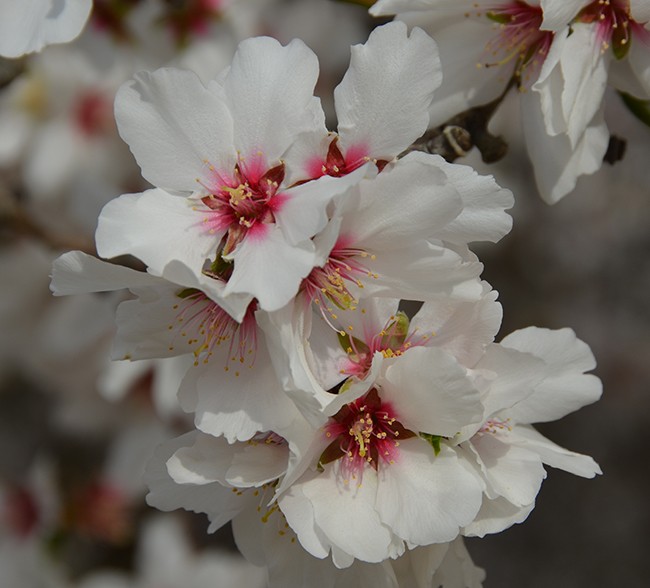Almond
(Prunus dulcis)

Description
The almond (Prunus amygdalus, syn. Prunus dulcis) is a species of tree native to Iran and surrounding countries and ancient remains of almonds were discovered in the Levant area. The almond is also the name of the edible and widely cultivated seed of this tree. Within the genus Prunus, it is classified with the peach in the subgenus Amygdalus, distinguished from the other subgenera by corrugations on the shell (endocarp) surrounding the seed. The fruit of the almond is a drupe, consisting of an outer hull and a hard shell with the seed, which is not a true nut, inside. Shelling almonds refers to removing the shell to reveal the seed. Almonds are sold shelled or unshelled. Blanched almonds are shelled almonds that have been treated with hot water to soften the seedcoat, which is then removed to reveal the white embryo. The almond is a deciduous tree, growing 4–10 m (13–33 ft) in height, with a trunk of up to 30 cm (12 in) in diameter. The young twigs are green at first, becoming purplish where exposed to sunlight, then grey in their second year. The leaves are 8–13 cm (3–5 in) long, with a serrated margin and a 2.5 cm (1 in) petiole. The flowers are white to pale pink, 3–5 cm (1–2 in) diameter with five petals, produced singly or in pairs and appearing before the leaves in early spring. Almond grows best in Mediterranean climates with warm, dry summers and mild, wet winters. The optimal temperature for their growth is between 15 and 30 °C (59 and 86 °F) and the tree buds have a chilling requirement of 200 to 700 hours below 7.2 °C (45.0 °F) to break dormancy. Almonds begin bearing an economic crop in the third year after planting. Trees reach full bearing five to six years after planting. The fruit matures in the autumn, 7–8 months after flowering. The almond fruit is 3.5–6 cm (1+3⁄8–2+3⁄8 in) long. In botanical terms, it is not a nut but a drupe. The outer covering or exocarp, fleshy in other members of Prunus such as the plum and cherry, is instead a thick, leathery, grey-green coat (with a downy exterior), called the hull. Inside the hull is a woody endocarp which forms a reticulated, hard shell (like the outside of a peach pit) called the pyrena. Inside the shell is the edible seed, commonly called a nut. Generally, one seed is present, but occasionally two occur. After the fruit matures, the hull splits and separates from the shell, and an abscission layer forms between the stem and the fruit so that the fruit can fall from the tree.
Taxonomic tree:







